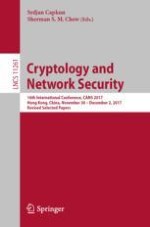This book contains revised versions of all the papers presented at the 16th International Conference on Cryptology and Network Security, CANS 2017, held in Hong Kong, China, in November/ December 2017.
The 20 full papers presented together with 8 short papers were carefully reviewed and selected from 88 submissions. The full papers are organized in the following topical sections: foundation of applied cryptography; processing encrypted data; predicate encryption; credentials and authentication; web security; Bitcoin and blockchain; embedded system security; anonymous and virtual private networks; and wireless and physical layer security.
